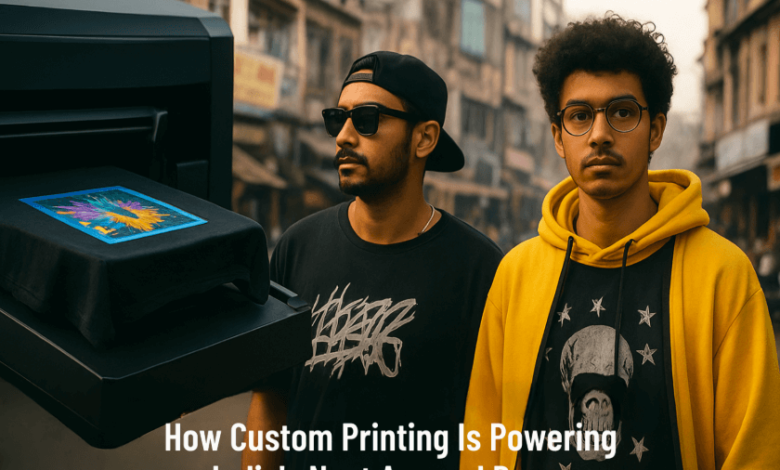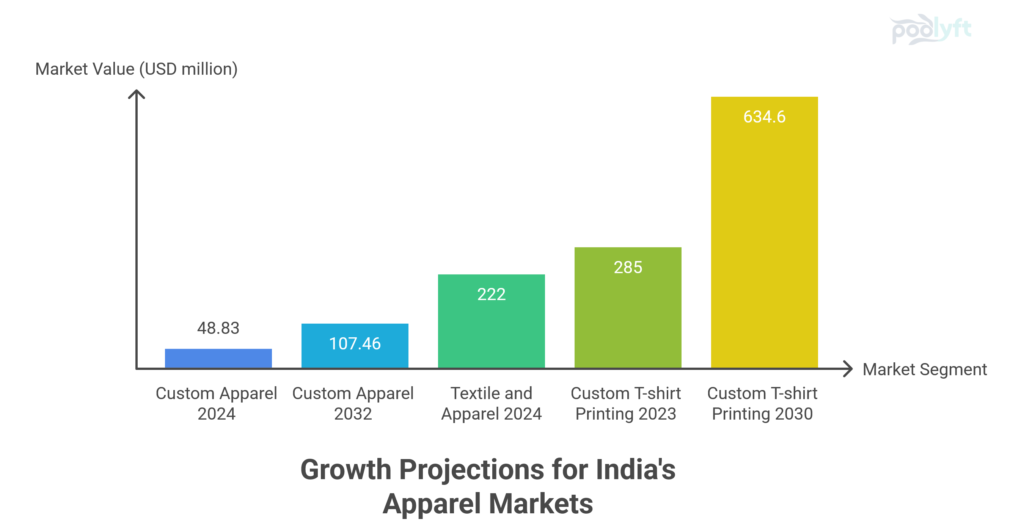How Custom Printing Is Powering India’s Next Apparel Boom: Profits, Tech & Street Style Trends

Intro
Over my 12 years in the textile and fashion industry, I have witnessed trends come and go. I have managed everything from sourcing premium cotton in Tirupur to advising global brands on their entry strategies into the Indian market. However, what I am observing now is more than just a trend; it represents a fundamental shift in how apparel is designed, produced, and consumed in India. The driving force behind this revolution? Custom printing.
The hum of a Direct-to-Garment (DTG) printer is becoming the new sound of opportunity for a generation of creators, entrepreneurs, and fashion enthusiasts. This is no longer just about printing a logo on a t-shirt. It represents a seismic shift that combines individual expression with astute business, driven by technological advancements and a strong demand for distinctive style. The growth of custom apparel in India has moved beyond a niche market; it is rapidly becoming mainstream.
Why Custom Apparel Is Exploding Across India
For years, the Indian apparel market was dominated by large-scale manufacturing and mass-market retail, where individuality often took a backseat to availability. Today, that narrative has been completely transformed. I witness this change every day in the vibrant street culture of Mumbai’s Bandra, the creative hubs of Bangalore’s Koramangala, and the bustling markets of Delhi.
The custom apparel market in India is experiencing rapid growth and demonstrates strong potential for the coming years. In 2024, the Indian custom apparel market was valued at approximately USD 48.83 million and is projected to more than double, reaching USD 107.46 million by 2032, with a compound annual growth rate (CAGR) of approximately 10.36%, reported by Credence Research.
This surge is driven by rising disposable incomes, increasing demand for personalized fashion, technological advancements that enable easier customization, and the expansion of e-commerce platforms facilitating on-demand apparel. India’s broader textile and apparel market was valued at over USD 222 billion in 2024 and is expected to grow rapidly, underscoring that the made-to-measure and custom apparel segments are integral parts of this expanding market landscape.
Furthermore, according to the research by GrandViewResearch, the custom t-shirt printing segment is particularly robust, with revenues reaching USD 285 million in 2023 and projected to grow to USD 634.6 million by 2030, at a compound annual growth rate (CAGR) of 12.1%. The popularity of customizable fashion among younger consumers, combined with India’s flourishing startup ecosystem—focused on unique, quick-turnaround, and eco-friendly apparel—is driving this trend.

The boom is powered by several key factors:
- The Rise of the Creator Economy: Social media influencers, artists, musicians, and comedians are no longer just promoting other brands; they are becoming brands themselves. Custom apparel is their most accessible form of merchandise, a direct line to their audience.
- A Hunger for Self-Expression: Gen Z and millennials are shunning cookie-cutter fashion. They want their clothes to tell a story—about their beliefs, their sense of humor, or their favourite pop culture moments. The demand for personalized apparel in India is a direct reflection of this desire for authenticity.
- The Dominance of Streetwear: Indian street style apparel trends are heavily influenced by global hip-hop, skate culture, and local art scenes. This aesthetic thrives on limited drops, graphic-heavy designs, and a sense of community, all of which are perfectly suited for custom printing models. Pioneers in this space, like PodLyft, are leveraging DTG printing India technology to cater to these fast-changing consumer tastes while keeping production agile and efficient.
The Business Model: Decoding Apparel Printing Profitability
When advising entrepreneurs aiming to enter the fashion industry, their greatest concern is often inventory risk. Ordering thousands of units of a single design represents a significant gamble. This is where the advantage of modern custom printing, particularly the print-on-demand (POD) model, becomes evident.
The concept is simple: you print a garment only after a customer has placed and paid for an order. For a startup apparel printing business in India, this approach is revolutionary. It virtually eliminates the need for a warehouse full of unsold inventory.
This low-inventory approach directly affects profit margins in custom printing. Although the cost per unit may be slightly higher than bulk screen printing, the financial risk is significantly lower. This enables anyone with a great idea—whether an artist, designer, or small business owner to test the market and start earning from custom t-shirts in India without requiring substantial upfront capital. It serves as the perfect bridge between creative passion and a sustainable lifestyle business.
The Technology That’s Changing the Game
My work often involves assessing production methods, and the evolution of textile printing innovation in India has been remarkable. Gone are the days when complex, multi-color designs required enormous setup costs. Digital printing has democratized the creation of high-quality apparel.
Let’s break down the key technologies:
| Printing Method | Best For | Quality & Feel | Cost Structure |
|---|---|---|---|
| Direct-to-Garment (DTG) | Detailed, multi-colour designs, photos, small batches, and on-demand orders. | Excellent detail, soft feel as the ink soaks into the fabric. | No setup cost per design. A consistent price per print, ideal for one-offs. |
| Screen Printing | Simple, one-to-three colour designs, large bulk orders (100+ units). | Vibrant, durable print that sits on top of the fabric. | High initial setup cost for screens. Cost per shirt decreases significantly with volume. |
| Direct-to-Film (DTF) | Versatile designs on various fabrics (polyester, cotton blends), vibrant colours. | A flexible, slightly raised feel. More durable than some older heat transfers. | Moderate setup. Good for both small and medium batches. |
While advancements in screen printing in India have improved efficiency, the real breakthrough for entrepreneurs is digital printing technology, particularly Direct-to-Garment (DTG) printing. DTG enables photorealistic prints with an unlimited color palette, a capability that was once prohibitively expensive for small production runs. Furthermore, the shift toward water-based, eco-friendly inks in DTG printing addresses the growing consumer demand for sustainable fashion choices.
Case Study: How Printing Fuels Modern Streetwear
Consider a small, independent streetwear brand operating from a studio in Delhi. Their audience is primarily online, following them on Instagram for their edgy, culturally relevant designs. How do they stay ahead?
They don’t guess what will sell; they use custom printing to their advantage.
- Test & Iterate: They can drop five new t-shirt designs as digital mockups on their social media.
- Gauge Demand: Based on likes, comments, and pre-orders, they know which two designs are winners.
- Produce On-Demand: They use a print-on-demand service to fulfill the orders for the popular designs. There’s no wasted stock of the other three.
- Create Exclusivity: They can market these as “limited drops,” creating urgency and enhancing brand value.
This agile approach embodies the essence of modern custom streetwear in India. It focuses less on mass production and more on fostering a direct conversation with the customer. For example, PodLyft’s Printed T-Shirts collection demonstrates how niche, graphic-driven designs can deeply resonate with Gen Z customers seeking unique statements that mass-market brands simply cannot offer. This is bespoke fashion in India made accessible.
The Real-World Challenges to Overcome
Of course, the path is not without its challenges. Success in the apparel printing business requires more than just a good printer. Based on my experience, here are the critical hurdles entrepreneurs face:
- Fabric Quality and Consistency: Not all cotton is created equal. The quality of a DTG print depends heavily on the garment’s fabric. Sourcing consistent, high-quality, 100% combed cotton t-shirts is a continual challenge, but it is essential for maintaining a premium brand.
- Quality Control: Ensuring that every print is sharp, vibrant, and correctly positioned requires rigorous quality checks, whether you are printing in-house or using a third-party service.
- Equipment Maintenance: A DTG printer is a sophisticated piece of machinery that requires regular maintenance to prevent nozzle clogs and ensure color accuracy. Downtime can be costly.
- Staying Ahead of Trends: The very speed that makes this market exciting also makes it demanding. What is trending today might become old news by next month. Constant research and creativity are essential.
The Future of Apparel Printing in India
The Indian apparel printing market is just beginning to develop. I foresee a future that is increasingly integrated, personalized, and technologically advanced. We are on the cusp of witnessing AI-powered design tools capable of generating unique patterns based on user input. Automation will streamline the workflow from online order to dispatch, further enhancing efficiency for bulk custom printing in India.
Although still in its infancy, discussions about 3D printing apparel in India are beginning to emerge, promising a future of highly customized garment construction. More immediately, I expect to see significant growth in tier-2 and tier-3 cities as internet penetration and aspirational consumerism continue to increase.
My Final Words
The convergence of technology, creator culture, and consumer demand has created a perfect storm of opportunity in the Indian apparel industry. For the first time, barriers to entry into the fashion world are incredibly low, while the potential to build a meaningful and profitable brand has never been greater.
This is not just about the growth of the fashion industry in India; it is about the democratization of style. It is about giving a voice to the individual. Whether you are an aspiring entrepreneur, a creative artist, or a discerning consumer, now is the time to embrace the custom apparel movement. It is where technology meets the street, shaping the future of Indian fashion, one unique print at a time.




